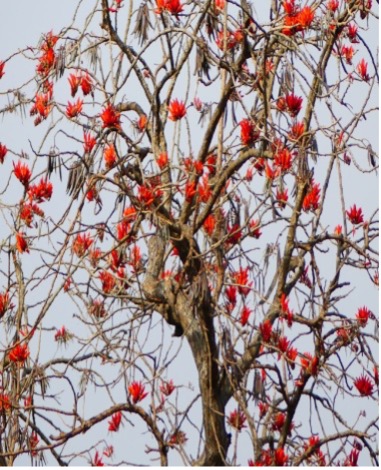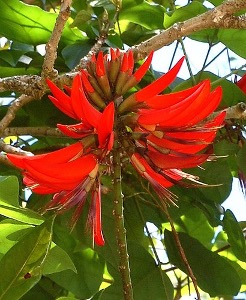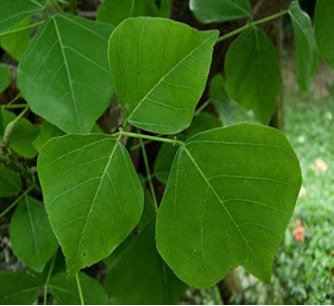HERBAL GARDEN
Vivek college of Ayurvedic Sciences & Hospital Bijnor UP
पारिभद्र



Classification
Synoyms
Paribhadra (Sanskrit)
Dadhiparna
Mandara
Coral Tree
Habit
Deciduous tree with thorny branches. Grows up to 10–15 meters tall.
Habitat
Found in tropical and subtropical regions of India, Sri Lanka, and Southeast Asia. Grows in dry forests, coastal areas, along roadsides, and in cultivated lands.
Morphology
- Leaves: Compound, trifoliate, broad ovate leaflets
- Flowers: Bright scarlet to orange-red, borne in dense terminal racemes
- Stem: Covered with conical prickles
- Fruits: Long, slender pods containing black seeds
Chemical Composition
Alkaloids (erysodine, erysovine)
Isoflavonoids
Tannins
Saponins
Flavonoids
Steroids
Triterpenoids
Glycosides
Guna-Karma
Rasa- Tikta (bitter), Kashaya (astringent)
Guna- Laghu (light), Ruksha (dry)
Virya- Ushna (hot)
Vipaka- Katu (pungent)
Karma- Krimighna, Jwaraghna, Kusthaghna, Vranaropana, Medohara
Doshakarma- Pacifies Kapha and Vata
Medicinal uses
Used in treatment of intestinal worms (krimi), especially roundworms
Leaf paste applied externally for swelling, ulcers, and boils
Bark decoction is used in fever, liver disorders, and skin conditions
Helps in obesity management and rheumatism
Flowers have mild laxative and diuretic action
Root bark used for wound healing and as an anthelmintic
Useful Part
Leaves
Bark
Roots
Flowers
Seeds (with caution)
Doses
Leaf juice: 10–15 ml
Bark decoction: 40–60 ml
Powder: 3–5 g
Important Formulation
Paribhadra Kwatha
Krimighna Yoga
Shloka
पारिभद्रः कृमिघ्नश्च लघुस्तिक्तो हिमोऽनिलान्।
विस्फोटकुष्ठकासघ्नः शोथारुचिकफापहः॥
Hindi Name
पंगारा / मंदार / पारिभद्र
English Name
Indian Coral Tree / Tiger’s Claw
Botanical Name
Erythrina variegata
Family
Fabaceae